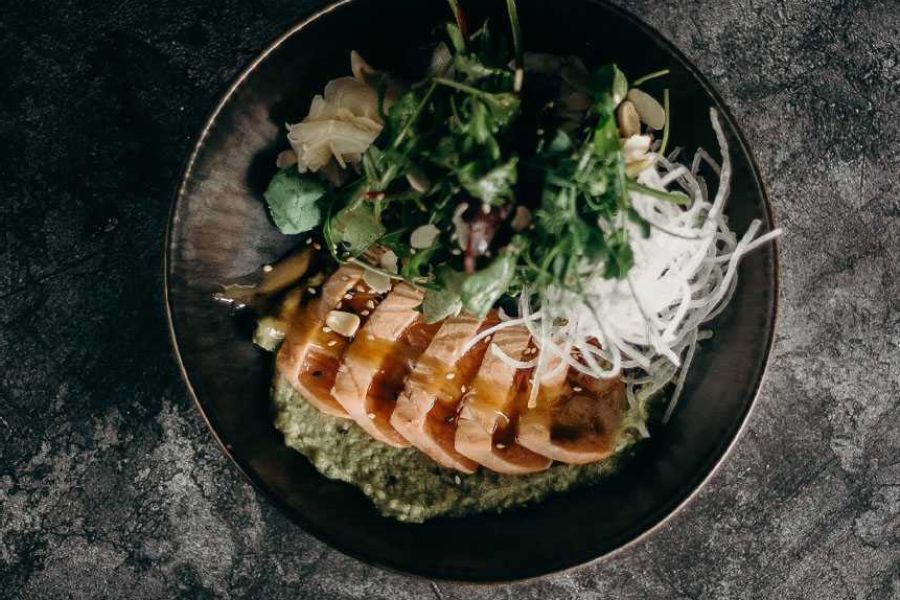Baked Salmon recipe is a dish where you can taste the exquisite flavours of tender salmon fillet and mayonnaise mixture. This salmon recipe is irresistible with its creamy and juicy flavour.
This baked salmon is an elegant and comforting fish dish with flavour, texture and culinary versatility. Salmon with a golden crust, moist and tender inside, aromatic herbs and spices... The perfect fish recipe for both special occasions and weeknight dinners.
When its slightly moist texture is combined with lemon, a delicious flavour emerges. Enhance your dining experience with this baked salmon recipe.
Tips
- Choose fresh salmon. When buying salmon, look for fresh salmon with firm flesh and vibrant colour.
- Rinse the salmon fillet under cold water and pat dry with paper towels. Remove the bones with tweezers if necessary.
- Season the salmon with salt, pepper and other herbs and spices of your choice.
- For an extra burst of flavour, marinate the salmon for 30 minutes to an hour before baking.
- Preheat the oven to about 200 °C (400 °F) to ensure even cooking.
- Line the baking tray with parchment paper or lightly oil it to prevent the salmon from sticking.
- Cook the salmon in the preheated oven for about 12-15 minutes per thickness. Cooking time may vary depending on the thickness of the salmon fillet. Use a meat thermometer to ensure it reaches an internal temperature of 63 °C (145 °F). Cook until the salmon flakes easily with a fork.
- Use salmon with or without skin. For a juicy and tender fillet, cook the salmon with the skin on. This helps to protect the fillet from the heat of the pan and cook the salmon more evenly. You can either remove the skin before serving or serve with the skin on. If you prefer skinless salmon, adjust the cooking time slightly. Because it can cook a little faster.
- Do not overcook the salmon. Otherwise, it may dry out and lose its flavour.
Let it rest before serving. After the salmon is cooked, remove it from the stove and let it rest for a few minutes. This allows the juices to redistribute and helps keep the fish moist.
Ingredients
- 6 salmon
- 2 tablespoons mayonnaise
- 1/2 tablespoon grated lemon
- 1/2 tablespoon dried thyme
- 1/2 tablespoon chilli flakes
- 1 bay leaf
- 1/2 teaspoon salt
- 1/4 teaspoon black pepper
Preparation
- Preheat the grill part of the oven to 190 °C (375 °F).
- Wash the fish and pat dry with a paper towel.
- Season with salt and pepper on both sides. Place the seasoned salmon on a baking tray.
- Spread a layer of mayonnaise on each fillet.
- Sprinkle with lemongrass, thyme, paprika and bay leaf.
- Bake for about 12-15 minutes per 2.5 cm (1 inch) thickness.
- Once cooked, remove the salmon from the oven and let it rest for a few minutes befor serving.
- Place the cooked salmon on a serving platter and serve with lemon wedges.
What is Baked Salmon?
Baked salmon is a dish of seasoned or marinated salmon fillet or steak cooked in the oven. This salmon recipe can be served with various side dishes such as roasted vegetables, rice or salad. It can also be used as a base for other recipes such as salads, sandwiches or pasta dishes.
Salmon is a type of fish that contains many vitamins, minerals and protein, especially omega-3 fatty acids and B12. It is very important for our health to have this fish on our tables frequently.
To cook salmon, add salt, black pepper and other desired herbs and spices to the fish. Place the salmon in the oven and bake at about 190 °C (375 °F). The exact temperature and cooking time may vary depending on the recipe and the thickness of the salmon fillets.
How can you tell when salmon is cooked?
To make sure the salmon is cooked,
- When fully cooked, the flesh of the salmon should be opaque and flake easily with a fork. The colour may vary depending on the type of salmon, but it should be cooked evenly on all sides.
- Using a meat thermometer is a reliable way to ensure that the salmon is cooked to the appropriate temperature. Insert the thermometer into the thickest part of the salmon fillet, avoiding any bones. Salmon is considered safe to eat when it reaches an internal temperature of 63 °C (145 °F). At this temperature, the salmon will be fully cooked, but still moist and tender.
- If you do not have a meat thermometer, you can use a general guideline for cooking times. Cook the salmon at about 190 °C (375 °F) for about 12-15 minutes per 2.5 cm thickness. Cooking times may vary depending on the size and thickness of the salmon fillet.
- Properly cooked salmon should have a tender and flaky texture. You can check this by gently inserting a fork into the thickest part of the fish and turning it gently. If the salmon flakes easily and the flesh separates into clean, distinct flakes, it is probably cooked.
Do not overcook the salmon. Because it can dry out and lose its flavour. Cook the salmon until it is slightly pink in the centre and has a moist texture. Allow the fish to rest for a few minutes before serving. This will help it retain its juiciness.
How to Serve Baked Salmon?
Baked salmon can be served with side dishes such as roasted vegetables, rice or salad. Roasted vegetables such as asparagus, Brussels sprouts, carrots or courgettes go well with baked salmon. Serve salmon with cooked grains such as quinoa, rice or couscous. A fresh salad can be a light and refreshing accompaniment to baked salmon.
